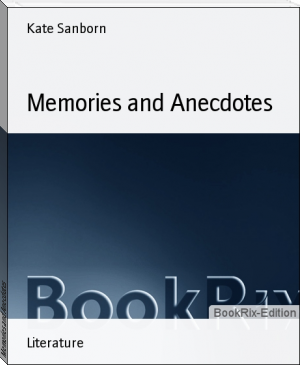Anecdotes of Painters, Engravers, Sculptors and Architects and Curiosities of Art (Vol. 3 of 3), S. Spooner [e novels for free .TXT] 📗

- Author: S. Spooner
Book online «Anecdotes of Painters, Engravers, Sculptors and Architects and Curiosities of Art (Vol. 3 of 3), S. Spooner [e novels for free .TXT] 📗». Author S. Spooner
handsome present. This picture was presented to the King of France, who
placed it in the Louvre. The King of Prussia visited Backhuysen, and the
Czar Peter took delight in seeing him paint, and often endeavored to
make drawings after vessels which the artist had designed.
JOHN BAPTIST WEENIX, THE ELDER.
This eminent Dutch painter was born at Amsterdam in 1621. He possessed
extraordinary and varied talents. He painted history, portraits,
landscapes, sea-ports, animals, and dead game, in all which branches he
showed uncommon ability; but his greatest excellence lay in painting
Italian sea-ports, of a large size, enriched with noble edifices, and
decorated with figures representing embarkations and all the activity of
commercial industry. In these subjects he has scarcely been surpassed
except by his pupil, Nicholas Berghem.
WEENIX'S FACILITY OF HAND.
Houbraken relates several instances of his remarkable facility of hand.
He frequently painted a large landscape and inserted all the figures in
a single day--feats so much admired in Salvator Rosa, and Gaspar
Ponssin. On one occasion he commenced and finished three portraits, on
canvass, of three-quarters size, with heads as large as life, from
sun-rise to sun-set, on a summer's day. Lanzi warns all artists,
especially the youthful aspirant, not to imitate such expedition, as
they value their reputation.
JOHN BAPTIST WEENIX, THE YOUNGER.
Was the son of the preceding, and born at Amsterdam in 1644. Possessing
less varied talent than his father; he was unrivaled in painting all
sorts of animals, huntings, dead games, birds, flowers, and fruit. He
was appointed Court painter to the Elector Palatine, with a liberal
pension, and decorated his palace at Bernsberg with many of his choicest
works. He painted in one gallery a series of pictures representing the
Hunting of the Stag; and in another the Chase of the Wild Boar, which
gained him the greatest applause. There are many of his best works in
the Dusseldorf Gallery. He painted all kinds of birds and fowls in an
inimitable manner; the soft down of the duck, the glossy plumage of the
pigeon, the splendor of the peacock, the magnificent spread of an
inanimate swan producing a flood of light, and serving as a contrast to
all the objects around it, are so attractive that it is impossible to
contemplate one of his pictures of these subjects without feeling
admiration and delight at the painter's skill in rivaling nature.
JAN STEEN.
The life of this extraordinary artist, if we are to believe his
biographers, is soon told. He was born at Leyden in 1636. He early
exhibited a passion for art, which his father, a wealthy brewer of that
city, endeavored to restrain, and afterwards apprehending that he could
not procure a comfortable subsistence by the exercise of his pencil,
established him in his own business at Delft, where, instead of
attending to his affairs, he gave himself up to dissipation, and soon
squandered his means and ruined his establishment; his indulgent parent,
after repeated attempts to reclaim him, was compelled to abandon him to
his fate. He opened a tavern, which proved more calamitous than the
former undertaking. He gave himself up entirely to reveling and
intoxication, wrought only when his necessities compelled him, and sold
his pictures to satisfy his immediate wants, and often for the most
paltry prices to escape arrest.
JAN STEEN'S WORKS.
The pictures of Jan Steen usually represent merry-makings, and the
frolics and festivities of the ale-house, which he treated with a
characteristic expression of humorous drollery, that compensated for
the vulgarity of his subjects. He sometimes painted interiors, domestic
assemblies, conversations, mountebanks, etc., which he generally
accompanied with some facetious trait of wit or humor, admirably
rendered. Some of his works of this description are little inferior to
the charming productions of Gabriel Metzu. His compositions are
ingenious and interesting, his design is correct and spirited, his
coloring chaste and clear, and his pencil free and decided. He also had
a good knowledge of the chiaro-scuro, which enabled him to give his
figures a fine relief. His works are invariably finished with care and
diligence, and do not betray any haste or infirmity of hand or head. It
is evident that, from some untoward circumstance, his works were not
appreciated in his day, but after his death they rose amazingly in
value, and have continued to increase ever since,--a true test of a
master's merit--till now they are scarcely to be found except in royal
and noble collections and the public galleries of Europe. His pictures
were, for a long time, scarcely known out of Holland, but now they are
deservedly placed in the choicest collections. His works are very
numerous, sufficient to have continually occupied the life time of not
only a sober and industrious artist, but one possessing great facility
of hand. Smith, in his Catalogue raisonné, vol. iv. and Supplement,
gives a descriptive account of upwards of 300 genuine pictures by
Steen, many of them compositions of numerous figures, and almost all of
them executed with the greatest care. It cannot be believed that a man
living in a state of continued dissipation and inebriety, could find
time to produce so many admirable works, displaying, as they do, a deep
study of human nature, and a great discrimination of character, or that
the hand of a habitual drunkard could operate with such beauty and
precision. Nor is it probable that a mind besotted by drink, and debased
by low intercourse, could moralize so admirably as he has done on the
evil consequences of intemperance and the indulgence of evil passions.
KUGLER'S CRITIQUE ON THE WORKS OF JAN STEEN.
Dr Kügler, a judicious critic, thus sums up his character as an artist:
"The works of Jan Steen imply a free and cheerful view of common life,
and he treats it with a careless humor, such as seems to deal with all
its daily occurrences, high and low, as a laughable masquerade and a
mere scene of perverse absurdity. His treatment of the subjects differed
essentially from that adopted by other artists. Frequently, indeed, they
are the same jolly drinking parties, or the meetings of boors; but in
other masters the object is, for the most part, to depict a certain
situation, either quiet or animated, whilst in Jan Steen is generally to
be found action more or less developed, together with all the
reciprocal relations and interests between the characters which spring
from it. This is accompanied by great variety and force of individual
expression, such as evinces the sharpest observation. He is almost the
only artist in the Netherlands who has thus, with true genius, brought
into full play all these elements of comedy. His technical execution
suits his design; it is carefully finished, and notwithstanding the
closest attention to minute details, it is as firm and correct as it is
light and free."
FROLICS OF MIERIS AND JAN STEEN.
Sandrart says that Mieris had a real friendship for Jan Steen, and
delighted in his company, though he was by no means fond of drinking as
freely as Jan was accustomed to do every evening at the tavern.
Notwithstanding this, he often passed whole nights with his friend in a
joyous manner, and frequently returned very late to his lodging. One
evening, when it was very dark and almost midnight, as Mieris strolled
home from the tavern, he unluckily fell into the common sewer, which had
been opened for the purpose of cleansing, and the workmen had left
unguarded. There he must have perished, had not a cobbler and his wife,
who worked in a neighboring stall, heard his cries and instantly ran to
his relief. Having extricated Mieris, they took all possible care of
him, and procured the best refreshment in their power. The next morning
Mieris, having thanked his preservers, took his leave, but particularly
remarked the house, that he might know it another time. The poor people
were totally ignorant of the person whom they had relieved, but Mieris
had too grateful a heart to forget his benefactors, and having painted a
picture in his best manner, he brought it to the cobbler and his wife,
telling them it was a present from the person whose life they had
contributed to save, and desired them to carry it to his friend
Cornelius Plaats, who would give them the full value for it. The woman,
unacquainted with the real worth of the present, concluded she might
receive a moderate gratuity for the picture, but her astonishment was
inexpressible, when she received the sum of eight hundred florins.
SIR ANTHONY MORE.
This eminent painter was born at Utrecht, in 1519. In 1552, he
accompanied the Cardinal Granville to Spain, who recommended him to the
patronage of the Emperor Charles V., whose portrait he painted, and that
of Prince Philip, which gave so much satisfaction to the monarch, that
he sent him to Portugal, to paint the portraits of King John III.,
Catherine of Austria his Queen, and sister to Charles, and that of their
daughter, the Princess Donna Maria, then contracted to Philip; he also
painted the portrait of Donna Catalina, Charles' younger sister; all of
which gave entire satisfaction, and the artist was munificently
rewarded, and the honor of knighthood conferred on him. The Emperor next
despatched More to England to take the portrait of the princess Mary
previous to her marriage with Philip of Spain. On this occasion, he is
said to have employed all the flattering aids of his art, and so
captivated the courtiers of Spain, with the charms of Mary's person,
that he was employed by Cardinal Granville and several of the grandees
to make copies of it for them. He accompanied Philip to England, where
he remained till the death of Queen Mary, who highly honored him,
presented him a gold chain, and allowed him a pension of £100 a year.
The Emperor Charles V. having abdicated in favor of his son Philip II.,
the latter returned to Spain, and made More his court-painter, where his
talents procured him great respect and abundant employment.
SIR ANTHONY MORE AND PHILIP II.
Philip II. was accustomed to honor More by frequent visits to his
studio, on which occasions he treated him with extraordinary
familiarity. One day, in a moment of condescension and admiration, the
monarch jocosely slapped More on the shoulder which compliment the
painter, in an unguarded moment, playfully returned by smearing his hand
with a little carmine from his brush. The King withdrew his hand and
surveyed it for a moment, seriously; the courtiers were petrified with
horror and amazement; the hand to which ladies knelt before they had the
honor to kiss it, had never before been so dishonored since the
foundation of the monarchy; at that moment the fate of More was balanced
on a hair; he saw his rashness, fell on his knees, kissed the King's
feet, and humbly begged pardon for the offence. Philip smiled, and
pardoned him, and all seemed to be well again; but the person of the
King was too sacred in those days, and the act too daring to escape the
notice of the Inquisition, from whose bigotry and vengeance the King
himself could not have shielded him. Happily for More, one of Philip's
ministers advised him of his danger, and without loss of time he set out
for Brussels, upon the feigned pretence of pressing engagements, nor
could Philip ever induce him to return to his court.
MORE'S SUCCESS AND WORKS.
More was employed by most of the princes of Europe, who liberally
rewarded him, and at every court his paintings were beheld with
admiration and applause, but at none more than at those of Spain and
England. He acquired an ample fortune. When he was in Portugal, the
nobility of that country, in token of their esteem, presented him, in
the name of their order, a gold chain valued at a thousand ducats. He
closely imitated nature. He designed and painted in a bold, masculine
style, with a rich tone of coloring; he showed a good knowledge of the
chiaro-scuro, and he finished his pictures with neatness and care; his
style is said to resemble that of Hans Holbein, though not possessing
his delicacy and clearness; and there is something dry and hard in his
manner. His talents were not confined to portraits; he painted several
historical subjects in Spain for the Royal Collection, which were highly
applauded, but which were unfortunately destroyed in the conflagration
of the palace of the Prado. While he resided in Spain, he copied some
portraits of illustrious women, in a style said to approach Titian. His
own portrait, painted by himself, charmingly colored, and full of life
and nature, is in the Florentine Gallery. His best work was a picture of
the Circumcision, intended for the Cathedral at Antwerp, but he did not
live to finish it, and died there in 1575.
PERILOUS ADVENTURE OF A PAINTER.
John Griffier, a Dutch painter of celebrity, went to London in 1667,
where he met with great encouragement. While there he painted many views
on the Thames, and in order to observe





Comments (0)